William Hemsworth's Blog, page 95
September 14, 2020
Apollinaris And The Natures Of Christ
Apollinaris is a figure in the early church that certainly has his share of controversy. At the young age of twenty, he was excommunicated for singing a hymn to the Greek god Dionysius.
He eventually would come back to Christianity and confessed the newly formed Nicean creed under the tutelage of Basil of Caesarea. In 360AD, he became bishop of Laodicea and was a supporter of St. Athanasius in his battle against the Arians.
Apollinaris Sought To Avoid Heresy
Apollinaris sought to circumvent the Arian view that Christ was a created being. He sought to deny the notions that the Logos dwelled within human nature of Christ, and wanted to establish and affirm the two natures, human and divine, of Christ.
He argued that Christ’s humanity could only result through divine union. In his letter On the Union of Christ in the Godhead Apollinaris writes, “And in this regard, he differs from every other body, for he was conceived in his mother not in separation from the Godhead but in union with it” (Norris 103). In his view this had to happen then the Logos would have descended upon a man, and that would mean that Jesus was just an ordinary man. This is the adoptionist mentality that Apollinaris was seeking to avoid.
As seen above, his views of Christ appear to be orthodox, but he would later stray. His desire to oust the Arian view would lead him into a bit of Christological trouble himself.
This all comes down to his definition of man. In the orthodox view, man is made up of flesh and a soul. Apollinaris took this a step further and taught a two-soul theology. In his view, man has an animal soul and a rational soul. Regarding this Apollinaris writes, “But the flesh is not soulless, for it is said to fight against the spirit and to resist the law of the intellect, and we say that even the bodies of beasts without reason are endowed with a soul” (Norris 108).

Unity With The Godhead
To complete the humanity of Christ Apollinaris says the animal soul was necessary, but the unity with the Godhead came to be when the rational soul of Christ became unified with the Logos. This unity replaced, even eliminated, the human soul of Christ.
This position was rejected, but some explanation must be made as to why. The human soul, as most of us can vouch for, is weak and can be swayed. In the view of Apollinaris, this soul, as previously stated, was replaced by a unity with the Logos.
If the human soul of Christ was replaced, that would mean that Christ was not completely human. He may have had flesh, but if his soul was replaced by a unity with the Logos then Jesus would lack a basic humanity. In short, he would not be able to identify with what we go through as Hebrews 4:15 states. Therefore, humanity is in the same condition it was before because the human nature of Christ was eliminated.
Works Cited
Norris, Richard A. The Christological Controversy. Fortress Press Philadelphia: PA, 1980. Print.
The post Apollinaris And The Natures Of Christ appeared first on William Hemsworth.
September 11, 2020
Glimmers Of Grace: A Review
One of the things that I enjoy doing is reviewing books for other writers. It is my act of solidarity with them and an appreciation for the extreme effort they put into their work. A few weeks ago I was offered the chance to review a new book. The book is titled Glimmers of Grace: Moments of Peace and Healing Following Sexual Abuse. The author, Faith Hakesley, put together this fantastic devotional from a very personal perspective. As a victim of clerical abuse, she shares her story of healing, perseverance and hope.
Glimmers of Grace: For The Survivor
On page 13 of the book Faith lays out four things that she wants readers to take away. First and foremost that, whether a victim or a loved one, you are not alone in the fight. Secondly that you find freedom and recognize the gifts that he Lord is offering you. Thirdly to assist in finding your own voice and validating your experiences. Lastly to encourage and seek help.
 Glimmers of Grace by Faith Hakesley
Glimmers of Grace by Faith HakesleyThe Reflection
The book itself is 171 pages long and packed full of powerful reflections. Faith shares her own experiences and one can’t help but to be drawn in. In reading the reflections I found myself to be challenged in my faith in a way previously not known.
This isn’t a bad thing, but s blessing. Each chapter begins with a scripture passage or a relevant quotation from a saint. Faith then elaborates on the quote with a relevant topic, and she does so with the wisdom of one who has lived several lifetimes.
Would I Recommend It?
This is a devotional I would certainly recommend. The author is forthright about her experiences, and one can see the light of grace working in the healing. The grace of Christ comes out brilliantly in the writing.
Each reflection is something that can easily be read in just a few minutes per day, but I was so enthralled that I read it in one sitting. It is very rare that a devotional has that effect. The end of each devotion has a prayer, a call to action, a step to deepen your faith, and questions for reflection.
Though you may not have had an experience like the author, you will still be challenged to examine your own experiences. This will challenge you to let go of hatred, develop compassion for others, and embrace the grace of Christ.
Where You Can Get Glimmers Of Grace
The book is published by Our Sunday Visitor and can be purchased here or anywhere books are sold.
Here is an interview with the author, Faith Hakesley, on CatholicTV.
The post Glimmers Of Grace: A Review appeared first on William Hemsworth.
September 9, 2020
Suffering And Growth In Holiness
Depending on the kind of suffering involved it is hard to see the light that it can bring. That light at the end of the tunnel seems distant. When St. Paul was writing to the church in Philippi he was writing to reassure them. He wants to encourage them to continue in the faith.
The Suffering Evangelist
The church founder was arrested, and it was well known that Christians were heavily persecuted in Rome. To see this clearly a closer look at Philippians 1:12 is in order. This beautiful piece of scripture states, “Now I want you to know, brothers and sisters, that what has happened to me has actually served to advance the gospel.” In captivity St. Paul becomes an evangelist to those in prison. He turns his prison cell into a chapel.
Paul saw being in prison as having a captive audience, and as a result he added members to the kingdom of God. This is something that we can incorporate into our own lives. When we go through trials do we see it as an exercise to increase our faith, or as an obstacle to our faith? When we go through various trials the Lord may be preparing us for events later on.
A Time of Preparation
It may be a way to better minister to a group, our families, or even our churches. Just as the suffering of Paul did not hinder his ministry, we must not let it hinder ours. He kept a positive attitude and accepted it as an honor to suffer on behalf of Christ. This is echoed in Philippians 1:13 where Paul writes, “As a result, it has become clear throughout the whole palace guard and to everyone else that I am in chains for Christ.”
No matter where we are or what we are going through there is someone who needs the gospel. How we handle our suffering may be the witness needed for someone to come to Christ. What a blessing it would be to be going through a hard time, but at the end of it your words and actions led someone to Christ? May we echo the words of St. Paul in Philippians 1:18, “What difference does it make, as long in every way, whether in pretense or in truth, Christ is being proclaimed? And in that I rejoice.”
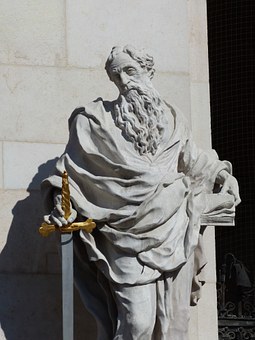
We Can Trust God
We cannot always trace the hand of God, but we can always trust the heart of God. His heart is devoted to working all things together for good for his people. We must be like Paul and focus on the end that Christ has in store for us. The enemy will try to discourage us with different trials, but we must proclaim Christ and rejoice that the gospel is being proclaimed in spite of what we are going through.
No matter what is going on in our lives, if we say we are Christians, then people are watching us. They are watching how we react, and how we live. When times get tough then talk is cheap. It is our actions that matter. Let us be like Paul and proclaim the Christ in every situation.
The post Suffering And Growth In Holiness appeared first on William Hemsworth.
September 8, 2020
Great Commission: We Are All Called To Evangelize
In the last several posts we have seen how the discipleship theme is deeply intertwined within Matthew’s Gospel. Matthew ends his Gospel with a call for discipleship that is popularly called the Great Commission.
The Great Commission is seen in Mt. 28:19-20 which states, “Go therefore and make disciples of all nations, baptizing them in the name of the Father and of the Son and of the Holy Spirit,teaching them to observe all that I have commanded you. And behold, I am with you always, to the end of the age.”
Thus far much detail has been given to a few sections of Matthew’s Gospel that deal with discipleship. One other that deals with it in Mt. 13:52. This passage speaks of scribes being trained for the kingdom and it will bring about treasure. This theme is one that starts at the beginning of the Gospel and ends at the Great Commission.
Christ gives a command to evangelize and to go forth and teach the world. This command is not strictly for the disciples that physically heard it, and it is not only for priests and deacons.
This command applies to all those who make the claim to follow Christ. This commission has its roots back in the Old Testament when the Lord told Abraham that all nations would be blessed in Genesis 22:18.
Responsibility Of All
This type of mission was not uncommon, but it did not happen vary often. There were occasions, such as Jonah, where God told someone to go to a foreign land to tell them to repent, but the Great Commission was a novelty. It was a clear-cut example that a new paradigm shift had been established and the old way was no longer the norm. This new way is one that must be made known to every creature (Mk 16:16). With his work on the cross and subsequent resurrection complete, the savior commission all believers to spread his message.
It is a mission that confirms the authority of Christ, a very clear set of instructions. In a way the disciples take the place of Jesus on earth though he is with them and working through them.
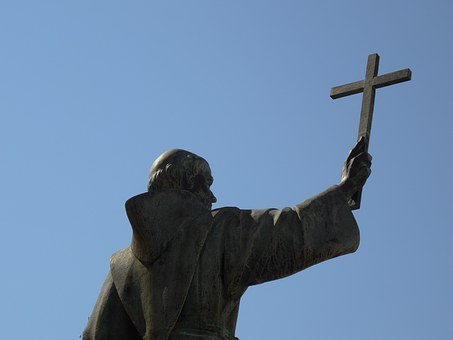
Sacrament Of Baptism
This passage is also where the trinitarian formula for baptism is seen. Matthew’s Gospel is the only synoptic that specifically lists it. It seems to bring to mind the baptism of John the Baptist at the beginning of the Gospel. Jesus submits to it, not because he needs to, but in effect to lead by example.
Most likely this wasn’t done to give authority to the baptism in which John was engaged. It was to give Christian baptism a new identity. One that was in the name of the triune God and revealed the unity of each member of the Godhead. It also brings us into the family of God and washes us of sin.
Throughout Matthew’s Gospel Jesus has been the teacher, but in the Great commission Jesus transfers this responsibility to the disciples. They are to teach what Jesus had taught them.
Christ Is With Us Always
One can only surmise what was going through the minds of the disciples upon hearing this. Perhaps anxiety, fear, or possibly utter terror. However, Jesus makes a profound promise that will last until the end of their lives, and indeed to them end of time itself.
Not only does this close out his Gospel, but it brings the description of Christ from the beginning of his Gospel back to the forefront. Jesus is the Christ, the son of the living God, Emmanuel which means “God with us”. Though we are here on earth doing the work that he has given us, his presence is with us and he is directing our paths.
How will you fulfill the commission of Christ? You have a gift that God has given you. Use it for Him and His Church.
The post Great Commission: We Are All Called To Evangelize appeared first on William Hemsworth.
September 3, 2020
Teach Your Children The Faith With These Steps
I have been called many things in my life: a good soldier, a solid worker, a model employee, and even a good husband. Those things are great and admirable, but they fail in comparison to my favorite title: dad. The Lord has blessed my wife and I with four awesome children, but with raising children goes much responsibility. Taking time to teach the faith is one of those.
You are probably thinking that I’m stating the obvious. After all, as parents we have to feed, clothe, and provide shelter for our family. These are great responsibilities and should not be minimized, but there is another enormous responsibility not on the above list. As parents we are also called to catechize our children.
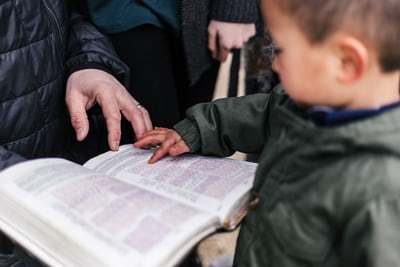
Photo by Priscilla Du Preez on Unsplash
Catechizing is Tough
Let’s be honest about something: the Church is losing young people in droves. I was recently listening to the Word on Fire podcast, and in that episode Bishop Barron said that for every person that enters the Church there are six who leave.
Why would someone leave the truth? The answer is quite simple: they leave because they do not know what the truth is. A majority of those who leave the Church do so because they have not been taught what the Church believes, and their questions have not been answered.
There are always exceptions, but it comes down to catechesis. In my time as a catechist I have heard familiar comment from parents, “Teaching about the faith is your job. I don’t know where to begin.” The purpose of this article is to give some guidance on where to start.
Teach Your Children about the Mass
The first step in catechizing children is to take them to Mass. I had seventeen students in my first year as a catechist, and only six of them went to Mass on a weekly basis. The catechism calls parents the primary teachers of the faith, and this is also reiterated in scripture several times. Children look to us parents as an example, and if the Church is not important to us, it will very likely not be important to them either.
When you are at Mass, explain to your children what is going on. Tell them how much scripture the Mass contains, why the priest says what he does during the consecration, and how the Mass is a foretaste of the wedding supper of the Lamb that takes place in heaven while we offer Mass here below. There is no filler in Mass – everything is important. The more children know, the more they will become engaged.
We are living in an unprecedented time. Public Mass is still suspended in some dioceses in the United States. Many priests and dioceses have taken it upon themselves to livestream their private Masses for our benefit. This is beneficial for all of us because the Mass is still happening. You can also find many of these Masses on YouTube, or you can record them from EWTN. This gives the added benefit of pausing to discuss the different aspects of the Mass.
Pray with Your Children
I have not always been very good at this step. I had the standard objections: “It’s too late” or “I’m too busy.” One evening I said good night to my son, and he said, “I would really like for you to pray with me before bed.” I learned something extremely important that night. Your children want you to pray with them. In doing so you become an example of what prayer is to them.
Is teaching prayer a priority or something you do in a passive way? If it is a priority for you then chances are it will be a priority for them too. In establishing a strong prayer life they, and we, understand more clearly just how much Christ loves us.
But remember that it is impossible to establish a strong relationship without dialogue. It is the same with prayer. There is no communion without dialogue. Prayer helps us establish a stronger bond with God, and that is something we desperately need to teach our children. We can talk about prayer until we are blue in the face, but there is no substitute for showing them how to do it. The more we show it, the more we’ll talk about its importance. As a result, our relationship with God will grow as will our relationship with our children.
In this uncertain time, ask your children if they have any prayer requests. They will chime in, and you can pray directly for their needs, their concerns, and those of their friends. You may also be surprised at what you learn about their lives when you do that.
Read Sacred Scripture with Your Children
Reading scripture with our children may seem like a given, but we must ask ourselves if we are doing it enough. When I say read scripture, I mean picking up the bible and reading it. This isn’t to say that children’s bibles and picture bibles can’t play an important role, but they should be complementary resources.
This will help children develop a deep love and appreciation for sacred scripture. This, in turn, will lead to more questions about the faith that we can answer. This will show the biblical basis for the Catholic faith and will help them withstand those anti-Catholic objections that will come in the future. When answering these questions, it is also important to be honest. If our children ask a question we do not know the answer to, it’s important to admit that. Then research it and come back with an answer.
There is no better time than the present to strengthen our commitment to scripture reading. This will replace a part of the screen time most children are getting while school is out. Teach them that the scriptures are love letters from God; this will underscore how important they are to our faith.
Conclusion
These three items are only a few of the many things you can do to teach your children the faith in these crazy times. Take the time and make a plan. The faith doesn’t stop, and it is our responsibility as parents to pass it on. We are being forced to slow down, and that’s a good thing. Let’s take advantage of this opportunity to teach our children about Christ and His Church.
The post Teach Your Children The Faith With These Steps appeared first on William Hemsworth.
September 2, 2020
Come To Christ And Get Rest
“Come to me, all you that are weary and are carrying heavy burdens, and I will give you rest. 29 Take my yoke upon you, and learn from me; for I am gentle and humble in heart, and you will find rest for your souls. 30 For my yoke is easy, and my burden is light.”-Matthew 11:28-30 NRSV
There is a saying that states that God works in mysterious ways. If ever we need rest the time is now. The burdens of life have been extremely heavy this year. There is much uncertainty about the future, and that is the cause of much anxiety more many. Myself included.
During the time of Christ there were many who were carrying heavy burdens. In today’s Gospel Jesus uses the analogy of the yoke. You may be picturing the yoke of an egg, but that is not what Christ is referencing. It is an agricultural term referencing the yoke that oxen wore that weighed heavily on their neck and shoulders. This was attached to the animals to carry heavy loads.

Come to Christ
What does this have to do with people? Like the oxen the audience of Christ, the people of Israel, were carrying heavy loads placed on them by the Pharisees. The Pharisees added to the law that it was impossible not to break one. Jesus showed them another way. He led by example and fulfilled the law. In the Gospel above he tells the people to come to him. He is not tyrannical, and will not give someone a yoke that they cannot carry. Jesus tells the people that they will find rest in them
Likewise we have sin weighing us down. We have all done something wrong, and over time the guilt will eventually get to us. Today Jesus tells us to come to him. Come to him to lift that yoke of sin off of our shoulders and neck. To come to Jesus is to experience true freedom. Let Jesus take that yoke of sin away from you. Find a priest and make an appointment for the sacrament of reconciliation. Experience the freedom that only Christ can give.
Saint Quotes
“A humble soul does not trust itself, but places all its confidence in God.” St. Faustina
“The secret of happiness is to live moment by moment and to thank God for all that He, in His goodness, sends to us day after day.” St. Gianna Molla
“Let no one mourn that he has fallen again and again: for forgiveness has risen from the grave!” St. John Chrysostom
“Hold your eyes on God and leave the doing to Him. That is all the doing you have to worry about.” St. Jane Frances de Chantal
The post Come To Christ And Get Rest appeared first on William Hemsworth.
September 1, 2020
March For The Martyrs September 5th
Sometimes we think that persecution of Christians is something that only happened at the beginning of the church. The fact is that the period in which we now live has the most Christian persecution in history. Many Christians march to martyrdom today, and it is more than you may think.
Christian persecution has increased 20% in just the last two years. Worldwide 260 million Christians face persecution for their faith. 260 million! Yet this huge number of people are widely ignored by popular media outlets.

March For The Martyrs
On September 5th, 2020 a March for the Martyrs will be taking place in Long Beach, California. The purpose is is to draw attention for this ignored crisis and to show our brothers and sisters that we stand in solidarity with them.
Event Schedule
3:30 PM – Kickoff Rally in Marina Green Park
Get ready to march with us as we gather and listen to great speakers at the Marina Green Park in Long Beach, CA.
4:30 PM – March for the Martyrs
Stand with the persecuted Christians and march in remembrance of those who have been martyred for the faith with March for the Martyrs. Our mission is to send a message of hope and a strong statement that
Christian Persecution will not be ignored, suffering Christians are not forgotten, and Jesus Christ still has the victory. March begins at the Marina Green Park and we will process through downtown Long Beach,
across the bridge over the Los Angeles River, and end at The Reef on the Water.
5:30 – 7:30 PM – Night of Prayer for the Persecuted at The Reef on the Water
Kickoff Rally in Marina Green Park
Addresses:
The Marina Green Park
384 E Shoreline Dr Long Beach, CA 90802
The Reef on the Water
880 Harbor Scenic Drive Long Beach, CA 90802
About The Organization And Founder
About For the Martyrs: For the Martyrs is a 501(c)3 non-profit charitable organization that seeks to bring awareness to the crisis of Christian persecution and advocate for religious freedom. https://forthemartyrs.com. To donate or learn more please visit www.marchforthemartyrs.com
About Gia Chacon: Founder of For the Martyrs, Gia Chacon is a humanitarian, speaker and Pro-Life Director of Bienvenido US. She first began her volunteer humanitarian efforts in 2017 and has traveled to Central America, East Africa, and as far as the Middle East. She has worked with the victims of hurricanes, natural disasters, hunger crisis, and refugees of war and persecution. Through working with refugees and hearing their stories, her first-hand experience in the Middle-East, as well as her extensive research of religious oppression, Gia felt called to make a larger impact for the suffering members of The Body of Christ, which led to the founding of For the Martyrs. In addition to her Pro-Life and Religious Freedom advocacy, and speaking at events, Gia has published and has been featured in news articles, on television and radio shows. Daily, she impacts culture through the media as @GenuinelyGia.
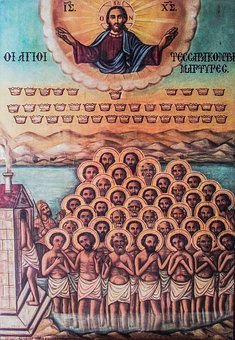 Icon of the forty martyrs
Icon of the forty martyrsThe post March For The Martyrs September 5th appeared first on William Hemsworth.
August 31, 2020
New Testament: Why Only 27 Books?
There are many things that may come to an individual’s mind when it comes to sacred scripture. Some may ask why there are so many translations. Some may wonder if the Bible as we know it fell from the sky at Pentecost. However many have questions on why we have the New Testament books we have. For sure it was long and arduous process, but it was one guided by the Holy Spirit and the church.
New Testament Books Have Apostolic Origin
One rule that was used to determine inclusion of the twenty seven books was linkage to an Apostle, or apostolic origin. In the first three centuries after the church started there were many books bearing the name of various Apostles.
As an example there was the Gospel of Thomas, Luke, Peter, and the proto gospel of James. In addition to these there were several hundred Acts and Apocalypses. Some of these writings were spurious and contradicted the Gospel being preached by the church.
Apostolic origin does not mean that it has to be written by an apostle, but that an Apostle “stands behind writing in such a way that the essential teaching is preserved within it (Nichols, page 104).” This would explain why the Gospel of Luke was included in the canon. Great care was made to ensure that writings had apostolic backing, and if they did not they were denied canonical status.
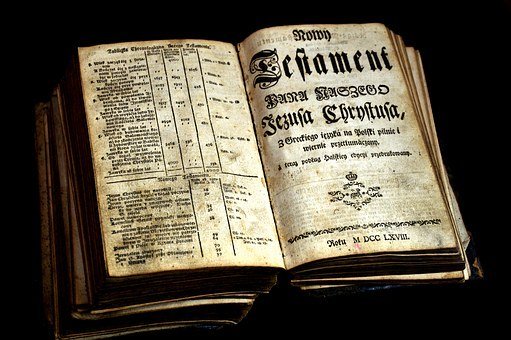
New Testament Books Had To Conform To The Faith
Another rule that was used in determining if a book was worthy of the New Testament canon was its conformity to the faith of the church. Would a collection of Holy writings from any religion be deemed authoritative if they contradicted each other? The answer to the question is obvious. The church used great care in determining that the twenty seven books in the canon were in compliance with what the church taught.
The church was able to do this by utilizing the sacred tradition that was handed down from the Apostles. As a Nichols documents “around 190 a bishop in Antioch stopped people from using the Gospel of Peter on the grounds that its author did not regard the human body of Jesus as real (Nichols, page 104).”
The church teaches that Christ was a real person, divine, and bled on the cross. This writing taught that Christ was a spirit that entered into a man that was being crucified. There were many writings like this floating around, and since they did not pass the test of orthodoxy they were not included in the canon.

Valued By A Church With Apostolic Origin
Thirdly the writing had to be valued by the church that was respected for its own Apostolic origin (Nichols, page 104). Perfect examples of this are the Epistles of Saint Paul. There is little doubt that these writings are his for he states at the end of letters that he wrote them with his own hand.
Also he wrote them to churches that he started and they knew him very well. These churches preserved these letters and read them in their liturgies.
Using these three criteria, the fathers of the church started to develop the New Testament. The letters of Paul were among the first to be recognized in 90 ad and were being assembled in small collections. The four Gospels were decided on around the year 200. By This I mean that the other gospels floating around that were deemed as not worthy of being in the New Testament.
There were various canons proposed, but the Pauline letters and the four gospels seemed to have staying power. Other books such as Revelation and Hebrews were battled over. Some areas of the church accepted them and others did not. There were also books with no apostolic link that were considered such as the Shepherd of Hermas and Clements letter to the Corinthians.
However they did not meet the criteria previously discussed and were denied canonical status. Through many debates and hefty quarrels we know that the canon was final by the end of the fourth century (Nichols, Page 105).
References
Nichols, Aiden. The Shape of Catholic Theology: An Introduction to Its Sources, Principles, and History. Collegeville, MN: Liturgical Press.
The post New Testament: Why Only 27 Books? appeared first on William Hemsworth.
August 28, 2020
The Cathars And Their Issue With The Eucharist
The Cathars are another famous sect in history that denied the real presence of Christ in the Eucharist. The Cathars were dualists as they believed in one god who was evil, and another that was good. The movement was essentially a revived type of Gnosticism as physical matter was also deemed evil.
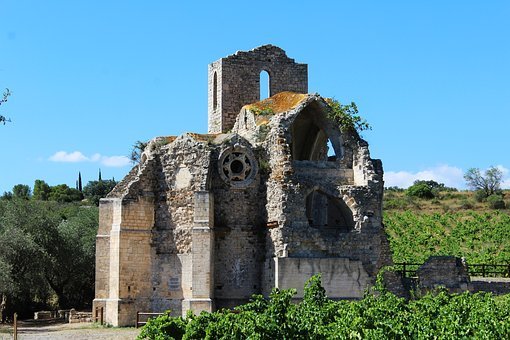
Cathars And Gnostic Roots
They denied that Jesus ever had a human body, and as result they would deny that the Eucharist was the body and blood of Christ. They denied all sacraments because of the physical properties contained within them. The Cathars thrived in Southern France between the 12th and 14th centuries.
The church had to respond swiftly as Catharism was a growing movement. The church used Aristotelian terms such as “substance” and “accidents” to describe the Eucharist.
The distinction between ‘substance’ and ‘accident’ gave the Church language to describe its belief that what looked like bread and wine were, in fact, the Body and Blood of Christ. This language brought forth a term that we use still today. The term “transubstantiation” was used against the Cathars at the fourth Lateran Council in 1215.
A Term For An Ancient Teaching
It was at this council that the teaching of the Cathars was formally condemned. The terminology that was developed during the controversy with the Cathars changed the landscape of Catholic theology. Transubstantiation may have been a new term to describe the miracle that happens on the altar, but it was by no means a new idea.
Transubstantiation was the term coined at the council, but not when the teaching started being taught. The church has always taught that the Eucharist was the body and blood of the Lord. Transubstantiation just gives the term to describe how it can be the body and blood of the lord and still look like bread and wine.
They were not Pseudo-Protestants as some make them out to be and are better known as Albigensians.
Basic Beliefs
The Cathars were dualists who believed in two gods. One who created everything good and another who created everything evil. Essentially they believed that the god of the Old Testament was Satan, and the New Testament was the God we know.
As they did with the Eucharist, they didn’t hold to the validity of any sacraments because the sacraments involve some kind of material. In their view all material is bad.
The human body was an evil construct because in entrapped angels in human flesh. Therefore anything to do with the human body was also deemed evil. Even procreation.
Suicide was seen as a good way of escaping human bondage.
Yes, they were opposed to the Eucharist as the Gnostics of old were. Their beliefs were dealt with by great saints such as St. Augustine and St. Irenaeus. Again I emphasize that they were not protestants that were persecuted by the Catholic church, but believers in type of modified Gnostic heresy.
The post The Cathars And Their Issue With The Eucharist appeared first on William Hemsworth.
August 24, 2020
Sainthood: What Does The Road Look Like?
“You cannot become a saint without becoming a human being first.” -St. Charbel Makhlouf, on sainthood, “Love is a Radiant Light”.
Sainthood Is The Goal
I was struck by this quote over the course of my spiritual readings. Such power and depth packed into one little sentence! In this piece I hope to unpack some of my thoughts behind this saying and its greater significance in our road to sainthood.
To become a saint is our great goal in this life on Earth as Christians. But what does it mean to become a saint? A saint is defined as a holy person who is chosen by God for a special purpose. All believers are called to be saints in one sense or another. We all have a special job on this earth that nobody else can do, be it St. Therese and her Little Way or St. Francis’s rebuilding of the Church.
Sainthood Is Growing In Virtue
To achieve that job in its fulfillment requires a multitude of sacrifices and of steps growing in virtue. To be a saint is to be an enemy of the way of the way of world, the way of the flesh, and the devil. Every sin mortifies the saint. Saints are totally dependent on Christ for all things. Above all, a saint is the servant of Christ, willing to conquer every aspect of their being for the greater good of being closer to God.
So how does one reach such heights? How can we hope to attain such sanctity? As with all things, it begins with a first step. Realizing that we are only human.
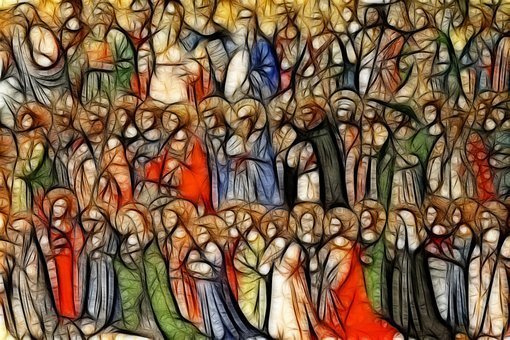
We Are Human
Coming to the realization that human beings in their nature are fearful and panicky, like sheep without a shepherd. Acknowledging before God that we are indeed in need of saving. That is what it means to become a human being. Our sin and weakness define us as the human race thanks to original sin.
We are in dire need of mercy.
But there is good news on sainthood!

There Is Good News
It doesn’t have to be this way. Our weakness can become our greatest strength if we allow God to make it so. How can we do this? By trading our sinful natures for humility before God. Humility is the basis of all other virtues. Nothing else good can spring forth otherwise.
Love without humility is selfish and self-serving. Charity without humility is an empty gesture. And so on. Humility is the most important thing in God’s grand economy. Love springs from humility, and from love springs mercy. Genuine Christian love and mercy for our fellow man is nothing without humility and humbleness before God. Remember only the penitent will pass!
Lessons From Saints
Being a saint does not mean to be a holy superman or superwoman. Quite the opposite actually! In
fact, saints know and revile their own sin. Saint John Bosco and Saint Patrick reinforce this idea
about sainthood:
Enjoy yourself as much as you like – if only you keep from sin.–Saint John Bosco
The Lord opened the understanding of my unbelieving heart, so that I should recall my sins.–Saint Patrick
As you can see the saint is fully aware of both their sinful natures and the saving power of God. The steps between human being and saint all start with the first step of humility. With that simple step, you too can march towards sainthood and achieve the highest of human potential. The road may seem endless but rest assured; God’s own Spirit will guide your steps if you let Him. I pray that we may all become saints one day and see the fullness of God in Heaven.
About Our Guest Blogger
Brian Caley is the owner of The Behold Project, a Catholic mental health ministry and blog. Please visit him at https://www.thebeholdproject.com or find him on Facebook at The Behold Project.
Brian currently lives in Pennsylvania with his wife Ruth and cat Snowball. In his spare time he tends his garden and plays board games.
The post Sainthood: What Does The Road Look Like? appeared first on William Hemsworth.
William Hemsworth's Blog
- William Hemsworth's profile
- 7 followers



